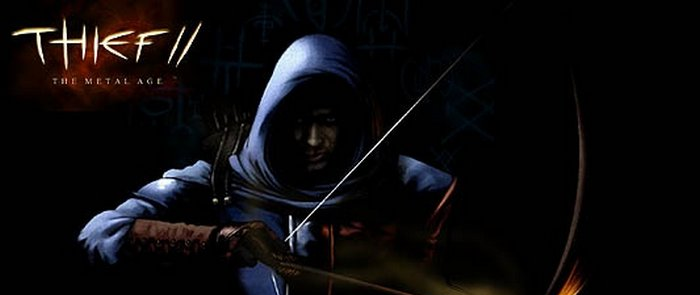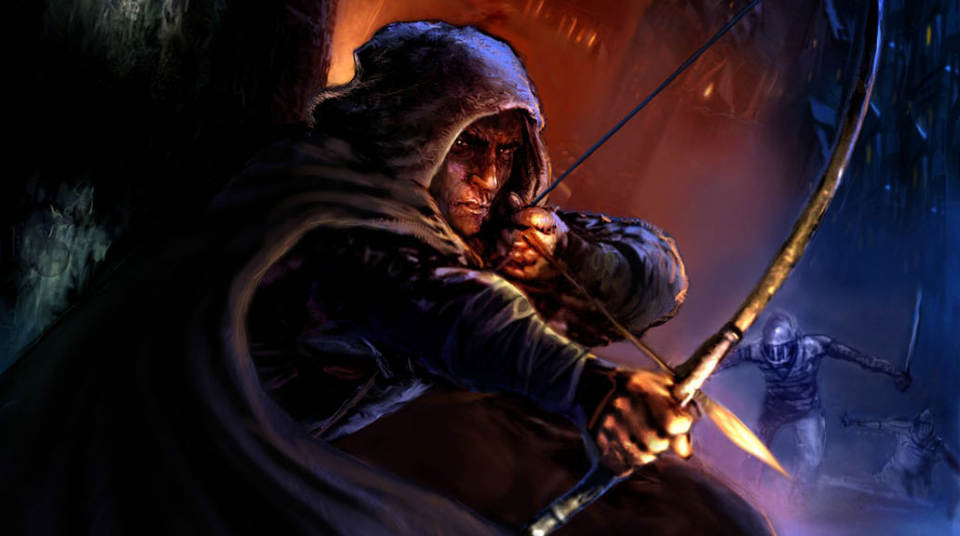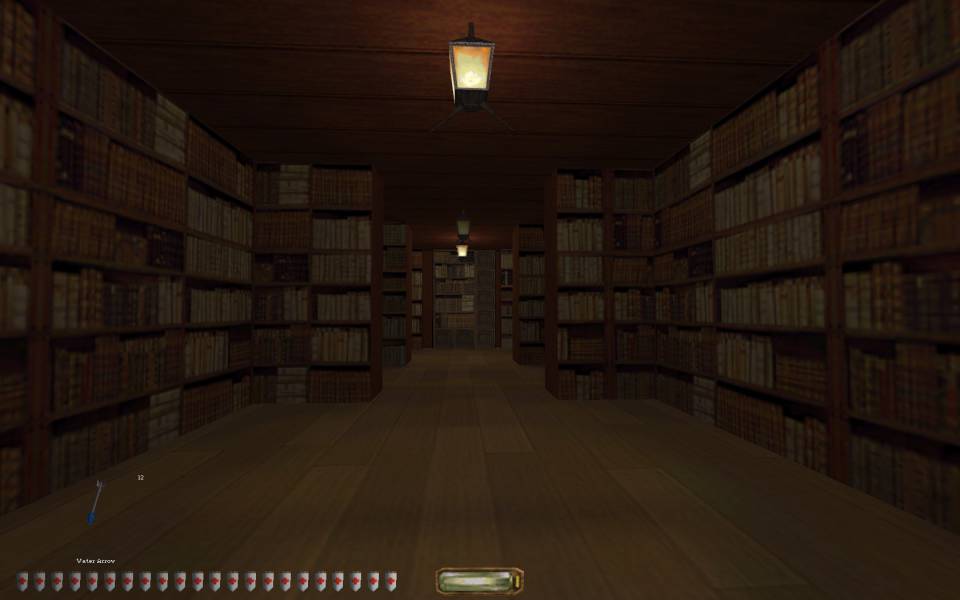Twelve Years Late: Thief II: The Metal Age
By m3ds334 7 Comments

Over the past few generations I've come romanticize stealth in games. Growing up as a Nintendo kid, I missed out on Metal Gear and didn't play a proper stealth based game until Ubisoft's Splinter Cell. It's probably this game that brought a sense of adoration for hero's hidden in shadows. It was just so appealing to see a character who took to evasion. Usually such cloak and dagger tactics were necessary because the opposition was so overwhelming that there was no other option, but what was even more engaging for me was evasion, not out of necessity, but out of challenge. It may be easy for me to clear out this room with a giant machine gun, but how much more stylish would it be to get through the room without anyone knowing I was there? This fascination with more rogue style characters transitioned from these stealth focused games into a wide range of other games I play. In rpg's I'll make a charismatic assassin, in Far Cry 3 I limited myself to the bow and the starting pistol, and I adore the idea of “no kill” playthroughs of games (even if I'm not always able to pull it off). Now with this love of stealth based gaming you may find it surprising to find out that, up until a week ago, I had never played any of the Thief titles. So with a bit of lull in current release schedule, I decided to rectify that and picked up Thief II: The Metal Age.
Now, as mentioned in the title, Thief II is an old game, and with that comes a few rough spots that over the last dozen years, have been refined. I could go on for a long time about these obtrusive parts. Things like the jump and climbing mechanics, how areas that graphically appear dark are classified as light by the game's detection system, and how there is no walk speed slow enough to avoid making noise, but rather you are forced to tap forward to inch your now noiseless body along. All of these sorts of issues seem rather null when discussing a game this old and don't cloud the things that make Thief special. So, instead of boring you with “old games were less player friendly than today's games,” I'd like to just talk about what makes Thief such a special stealth title, and how, even today, it's ability to provide the player with an experience that fulfils the fantasy of being a thief is unmatched.
In Thief II, the player controls the character of Garrett, a man labelled as a master thief. Garrett provides a good avatar for a thief experience. He makes flippant remarks as he navigates the world, his appearance is almost never seen (using your scouting is really the only way to see his outfit), and most importantly, he's the last of his kind. Early on in the game Garrett narrates that the city watch has been coming down on crime with greater force over the last while, to the point that he is one of the last remaining thieves. Right away this identifies the player as someone unique, a thief who, in spite of ever imposing odds, has managed to stay free and profitable. Really though, this is about as far as the story goes to aiding the notion that the player is this elusive larcenist. Instead of overtly telling the player they're a great thief, Thief II lets them be a great thief.

To me, one of the defining features of thieves is that they always look out for themselves first and as a result, usually have to rely on their own wits and abilities. Thief II fully embraces this archetype in both it's gameplay and story by isolating Garrett. There is no superior in your ear criticizing your actions, but this also means there is no help for this lone thief. Saying that though, the player is not totally devoid of help. As Lambert ques Sam Fisher into plot details in Splinter Cell, Garrett's narration alerts the player of various gameplay mechanics and story ques. However, because these comments are coming from the character the player is controlling, it creates a far greater sense of self reliance and maintains this reclusive persona that Garrett has going on. Furthering this is the game's emphasis on resource management.
At the start of each level the player is given the chance to buy a variety of tools and ammo to bring into the next level. Very little of what the level contains is disclosed to the player (this level is set on the rooftops, so maybe I should buy more rope arrows), and so one is forced to make purchases on what they think they might need. Save for a few random arrows and flash bombs scattered throughout each level, this is the only equipment provided. This lack of knowledge and finite resources creates great dilemma’s throughout each level as one has to decide whether it's better to use up the provided water arrow's in a particular bright hallway, allowing one to easily slip by, or save them on the off chance that the later rooms contain enemies which can only be subdued by the scarce ammo. This lack of aid pushes the idea that Garrett is alone and also manages to create a sense of accomplishment. I can see how such design is risky. I know there was one level where I mismanaged my ammo and it made the last section of the level particularly frustrating, but when correctly managed it leaves a person with the impression that they have the same knowledge as Garrett when it comes to the decision of going all in or holding back. But what happens when things do go awry? Traditionally, the master thief always has a trick up his sleeve to get out of a tight spot, and it is really hear that Thief II shines. Thanks to the game's level design and the tools at the players disposable, Thief II allows for eureka moments where the player get to use their own ingenuity.

Thief II provides a wide variety of tools in the form of Garrett's various equipment. There are water arrows to put out the various torches within each level. There are moss arrows that dampen the sound of Garrett's walking. Garrett can also climb ledges that are within his reach. Along with a variety of other standard thieving equipment that is featured in countless other similar games. What separates Thief II from many other stealth based games is that the game never tells you exactly when it's best to use such tools. It provides you with a basic outline of how they work, but then charges the player with the task of finding out their full potential. In many games with such a wide gamut of abilities, it often seems that specific sections are built around specific abilities. “Now is the time to use the teleport ability, now is the time to use the slow time ability,” and so on. Thief never has these sort of imposed strategies, but rather opts to leave the player in charge of how to best overcome the obstacles faced. Now, there are other games that give a wide range of tools like Thief II, but where Thief really capitalizes is in it's level design.
The level design in Thief II is what pushes the game from a great stealth game to a game that frequently makes “top 100” lists. Levels in Thief strike the perfect balance between hand crafted design and free form. A level in thief is specifically crafted so that a lot of the tools can actually be utilized. Many ceilings will be grapple points for your rope arrows, torches line the halls, but are positioned so that extinguishing them would provide excellent cover from patrolling guards, and patrols take just long enough for you to pick the lock on a door and slip inside without being noticed. However, none of these paths feel forced onto one play style or another. Sometimes in Deus Ex, a level can be structured so that it can feel like “here's a vent for stealth based characters, here's a room with rocket ammo for explosive minded individuals, here's a security room for hackers, and here's a super long tunnel filled with water for swimmers (yeah right, who levels swimming).” In Thief, it's far more organic. Often times I would get through an area with one method, die, and then upon reloading my save, go through the same area in a way I hadn't realized before. This can be partly chalked up to the fact that there is no rpg levelling system in Thief. As much as I love levelling in games, it can be a deterrent in terms of player experimentation. If I'm heavily invested in lock picking, I simply don't have the necessary skills to try out other option when trying to infiltrate a compound. By linking player abilities with equipment, Thief ensures that your options are always open. And for me, this is where Thief delivers it's greatest feature, by providing the player with a set of tools and arena that, though designed, is left open for the player to experiment with, the player relies on their own wits and abilities to overcome opposition, not the designers. Having this level of agency allows for moments of sheer player authored ingenuity. As Portal makes you feel like a genius for figuring out a tough puzzle, Thief makes you feel like the quick thinking rapscallion that the game has you playing by actually having you devise how best to avoid detection.
The game is of course not without it's share of problems in these key mechanics. Gold does not carry over from level to level, which sort of flies in the face of the resource management presented through the items in the game and I found that in the back third of the game, level design did begin to falter as paths became a bit more restricted and alternate routes a bit more obvious. That said, I love a lot of the stealth games I've played over the years, but I can't think one that puts the onus of evasion on the player like Thief II: The Metal Age does.
